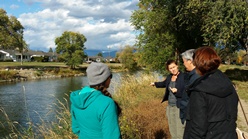
Last week Grants Manager David Hendrickson, along with CEO Jack Wong and board member Anna Warwick Sears, visited regional, municipal and First Nation government representatives from Vernon to Keremeos to learn about initiatives and issues in the Okanagan region. One highlight was seeing salmon spawning in Penticton. Healthy fisheries are an indicator of healthy watersheds, an important focus of our Freshwater Sustainability granting area.
Imagine returning from a trip to Japan, crossing over to Alaska, passing down to Portland, and then swimming 900 kilometres up the Columbia River, jumping over nine dams, and finally arriving in Penticton on the edge of Lake Okanagan.
This was what Jack, Anna and I witnessed as we saw some of the first sockeye salmon spawning in the Penticton Channel after a 100 year absence. The glistening blood-red backs of sockeye were close enough to touch as they hovered there in the channel having returned from a miraculous journey.
 Later, we toured the recently opened k]cpә’lk’ stim’ Salmon Hatchery on Penticton Indian Band land, which will be able to release up to eight million sockeye fry annually into Shingle Creek.
Later, we toured the recently opened k]cpә’lk’ stim’ Salmon Hatchery on Penticton Indian Band land, which will be able to release up to eight million sockeye fry annually into Shingle Creek.
The hatchery opening is a historical achievement for Okanagan Nation Alliance, which has been working for the past twelve years on the initiative. In the mid-1990’s returns to the spawning grounds north of Oliver were as low as 5,000 fish. It is a testament to the perseverance of the Syilx people, who are realizing the dream of restoring the sockeye run as it once was. It is part of a long-term program to restore sockeye in the upper Okanagan watershed, Okanagan Lake and Skaha Lake systems, which make up part of the Columbia River basin.
Their approach towards salmon restoration is really quite simple: find some passionate people, engage with the community, improve the stewardship of the land, move on to the next river and repeat.
– David Hendrickson
SHARE